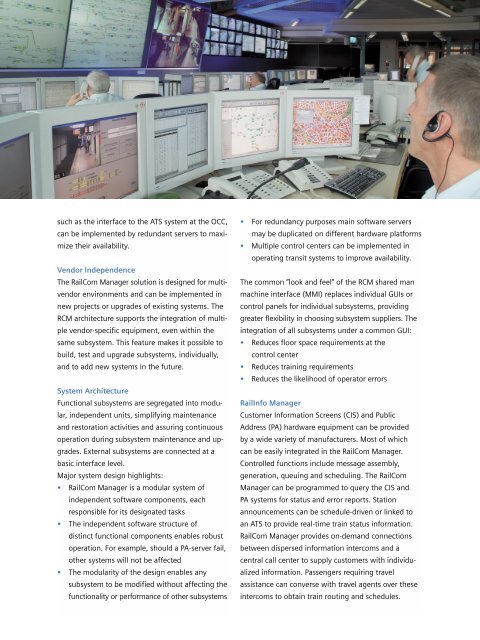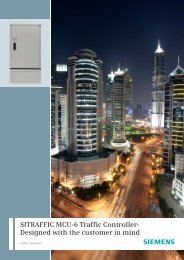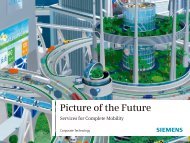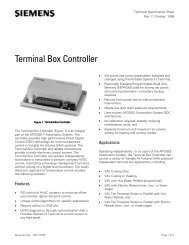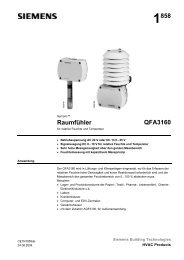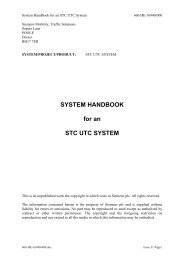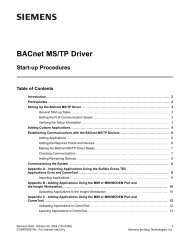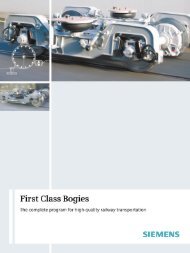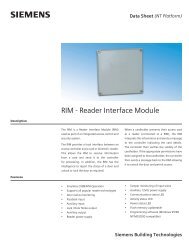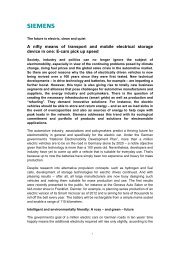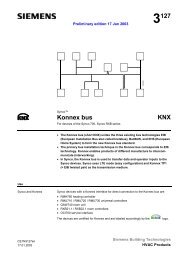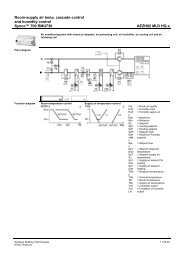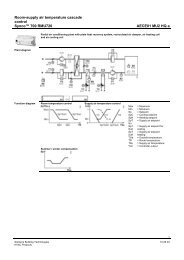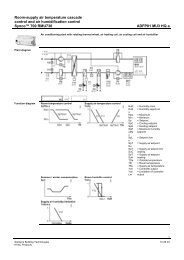Siemens RailCom Manager Optimizing Rail Communication
Siemens RailCom Manager Optimizing Rail Communication
Siemens RailCom Manager Optimizing Rail Communication
You also want an ePaper? Increase the reach of your titles
YUMPU automatically turns print PDFs into web optimized ePapers that Google loves.
such as the interface to the ATS system at the OCC,<br />
can be implemented by redundant servers to maximize<br />
their availability.<br />
Vendor Independence<br />
The <strong><strong>Rail</strong>Com</strong> <strong>Manager</strong> solution is designed for multivendor<br />
environments and can be implemented in<br />
new projects or upgrades of existing systems. The<br />
RCM architecture supports the integration of multiple<br />
vendor-specific equipment, even within the<br />
same subsystem. This feature makes it possible to<br />
build, test and upgrade subsystems, individually,<br />
and to add new systems in the future.<br />
System Architecture<br />
Functional subsystems are segregated into modular,<br />
independent units, simplifying maintenance<br />
and restoration activities and assuring continuous<br />
operation during subsystem maintenance and upgrades.<br />
External subsystems are connected at a<br />
basic interface level.<br />
Major system design highlights:<br />
• <strong><strong>Rail</strong>Com</strong> <strong>Manager</strong> is a modular system of<br />
independent software components, each<br />
responsible for its designated tasks<br />
• The independent software structure of<br />
distinct functional components enables robust<br />
operation. For example, should a PA-server fail,<br />
other systems will not be affected<br />
• The modularity of the design enables any<br />
subsystem to be modified without affecting the<br />
functionality or performance of other subsystems<br />
• For redundancy purposes main software servers<br />
may be duplicated on different hardware platforms<br />
• Multiple control centers can be implemented in<br />
operating transit systems to improve availability.<br />
The common ”look and feel” of the RCM shared man<br />
machine interface (MMI) replaces individual GUIs or<br />
control panels for individual subsystems, providing<br />
greater flexibility in choosing subsystem suppliers. The<br />
integration of all subsystems under a common GUI:<br />
• Reduces floor space requirements at the<br />
control center<br />
• Reduces training requirements<br />
• Reduces the likelihood of operator errors<br />
<strong>Rail</strong>Info <strong>Manager</strong><br />
Customer Information Screens (CIS) and Public<br />
Address (PA) hardware equipment can be provided<br />
by a wide variety of manufacturers. Most of which<br />
can be easily integrated in the <strong><strong>Rail</strong>Com</strong> <strong>Manager</strong>.<br />
Controlled functions include message assembly,<br />
generation, queuing and scheduling. The <strong><strong>Rail</strong>Com</strong><br />
<strong>Manager</strong> can be programmed to query the CIS and<br />
PA systems for status and error reports. Station<br />
announcements can be schedule-driven or linked to<br />
an ATS to provide real-time train status information.<br />
<strong><strong>Rail</strong>Com</strong> <strong>Manager</strong> provides on-demand connections<br />
between dispersed information intercoms and a<br />
central call center to supply customers with individualized<br />
information. Passengers requiring travel<br />
assistance can converse with travel agents over these<br />
intercoms to obtain train routing and schedules.


